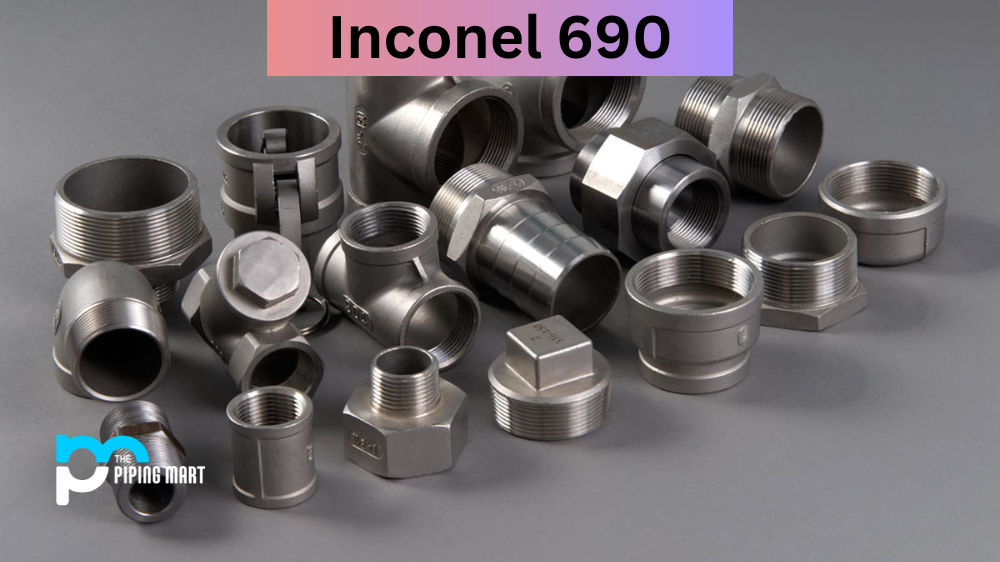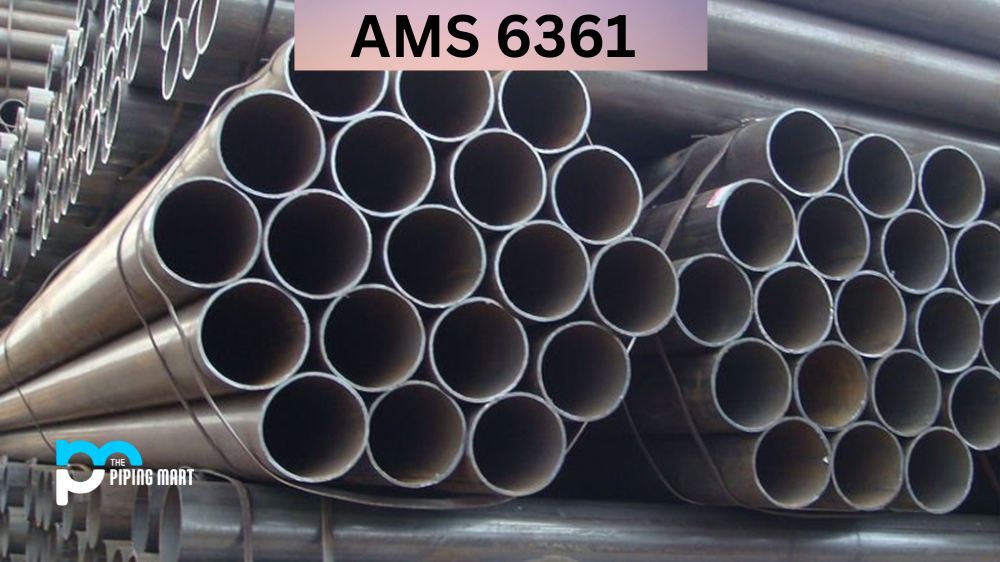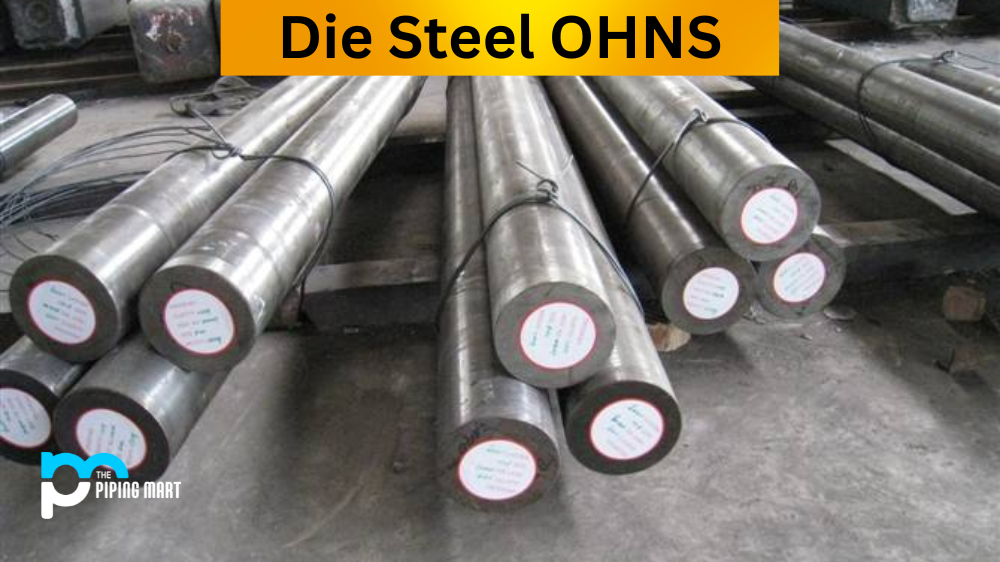UNS N06690 is an alloy composed of nickel, chromium, and other elements. It has excellent mechanical properties and corrosion resistance, making it an ideal choice for a variety of applications. Let’s explore the composition, chemical properties, mechanical properties, physical properties, uses, corrosion resistance, heat resistance and treatment, machining techniques, and welding techniques of Inconel 690.
690 Inconel Chemical Composition
UNS N06690 is composed primarily of nickel (66-70%), chromium (20-23%), iron (9-13%), and molybdenum (1%). Small amounts of silicon, manganese, and carbon are also present in the alloy.
| Element | Content (%) |
|---|---|
| Chromium, Cr | 27-31 |
| Iron, Fe | 7-11 |
| Silicon, Si | 0.5 max |
| Manganese, Mn | 0.5 max |
| Copper, Cu | 0.5 max |
| Silicon, Si | 0.5 max |
| Carbon, C | 0.05 max |
| Sulfur, S | 0.015 max |
| Nickel, Ni | Remainder |
690 Inconel Chemical Properties
The alloy exhibits good oxidation resistance at high temperatures with excellent resistance to pitting and stress-corrosion cracking. It is nonmagnetic in the annealed condition but may become slightly magnetic when cold worked or exposed to elevated temperatures.
690 Inconel Mechanical Properties
UNS N06690 has good strength and ductility at both room temperature and elevated temperatures up to about 1600°F (871°C). It also has excellent creep rupture strength making it a good choice for parts that are subjected to high temperatures over long periods of time. Additionally, it has a good thermal conductivity which makes it suitable for use in heat exchangers or as cladding on fuel rods in nuclear reactors.
| Properties | Metric | Imperial |
|---|---|---|
| Poisson’s ratio | 0.29 | 0.29 |
| Hardness | 85 | 85 |
690 Inconel Physical Properties
The 690 inconel alloy has a density of 8.2 g/cm3, which makes it lighter than steel or aluminium alloys but heavier than titanium or magnesium alloys. It also has a relatively low coefficient of thermal expansion, which makes it suitable for use in components that must maintain their shape under changing temperatures. Additionally, its low thermal conductivity makes it well suited for use as cladding on fuel rods in nuclear reactors since less heat will be conducted away from the fuel during operation.
| Properties | Metric | Imperial |
|---|---|---|
| Density | 8.19 g/cm³ | 0.296 lb/in³ |
| Melting point | 1343-1377°C | 2450-2510°F |
690 Inconel Thermal Properties
| Properties | Metric | Imperial |
|---|---|---|
| Thermal conductivity | 12.1 W/mK | 84 BTU in/hr.ft².°F |
690 Inconel Equivalent
- ASTM B167
- DIN 2.4642
690 Inconel Uses
Inconel 690 is used extensively in applications where corrosion resistance is needed, such as petrochemical plants and marine environments where saltwater corrosion can be a problem. Additionally, its excellent mechanical properties make it suitable for use in aerospace components such as engine blades or turbine vanes where high temperatures are encountered during operation. Its good oxidation resistance also makes it useful for furnace linings or exhaust systems where hot gases must be contained without corroding the part too quickly due to oxidation reactions with air or other gases. Finally, its low coefficient of thermal expansion makes it suitable for use as a cladding material on fuel rods in nuclear reactors since less expansion will occur during operation compared to other materials like steel or aluminium alloys which may expand more quickly under the same conditions leading to premature failure of the cladding material due to excessive stresses caused by differential expansion rates between cladding layers and fuel rod itself.
Corrosion Resistance
Inconel 690 has become an increasingly popular option in industrial applications due to its impressive corrosion resistance. Its ability to resist corrosive elements such as sulfuric acid, nitric acid and many others makes it perfect for environments where these contaminants are present. The material also resists pitting and crevice corrosion of the metal in both acidic and basic solutions, making it suitable for a variety of different scenarios. On top of this, its unsurpassed resistance to stress corrosion cracking makes Inconel 690 one of the top choices for those who need metal fabrication which is up to the challenge.
Heat Resistance
Inconel 690 has been used for decades in many industrial applications due to its superior heat resistance and corrosion-resistant qualities. It has a melting point of 2550 degrees Celsius, making it ideal for the most extreme thermal conditions. In addition, it can be used in both oxidizing and reducing environments without fear of oxidation or deformation. This makes it the perfect alloy for applications that need to withstand extremely high temperatures and harsh chemical environments like oil and gas production or chemical processing plants. It is also an excellent choice for ultra-high temperature furnaces and reactors, as well as power generation facility components. With its exceptional heat resistance, Inconel 690 is a versatile alloy that can be depended on for years of reliable performance in even the most demanding situations.
Heat Treatment
Inconel 690 is an alloy that has excellent weldability and corrosion resistance due to its high alloy content. It is suitable for use in intense industrial environments, such as oil refining and power generation, where temperatures exceed the maximum capabilities of carbon steel and stainless steel. As a result, proper heat treatment of Inconel 690 is essential to ensure it resists cracks and distortion during use. Depending on the application, the heat treatment may be performed in air or oil at multiple temperature stages with cooling cycles in between each stage to create evenly distributed grain structures throughout the alloy. The combination of its alloy composition, heat treatment process, and various methods of testing enhance its stability under stress conditions in order to survive extreme long-term usage.
Machining
Inconel 690 is a high-performance nickel-chromium alloy known for its corrosion and oxidation resistance, making it ideal for machining in extreme hot and cold temperatures. It stands up to a wide range of acids, alkalis, and chloride solutions, making it the perfect choice for environments where heavy contamination may occur. Inconel 690’s superior machinability means that the material can be machined with great accuracy while still achieving superior air leakage control and long-term reliability. This makes it an ideal choice for applications such as watertight connectors, auto exhaust systems, oil production equipment, valve components, and other projects requiring precision and quality. With its combination of flexibility and performance capabilities, Inconel 690 machining will provide you with reliable results time after time.
Welding
Welding Inconel 690 can be challenging due to its high chromium and nickel content. It’s a nickel-based series superalloy used for applications involving high temperature, oxidation resistance, and hydrogen embrittlement. This welding process requires careful technique and perfect execution of joint design in order to avoid mechanical damage or premature failure down the line. Working with knowledgeable professionals and having the right equipment on hand can make this process much easier and more efficient. With the help of meticulous weld preparation and post-weld treatments, Inconel 690 welding can be successful in the right hands.
Conclusion
In conclusion, the properties and superior qualities of Inconel 690 make it an ideal material for applications in a wide variety of industries. This metal alloy offers excellent performance under extreme temperatures and corrosion-resistant properties that are second to none. The combination of these two attributes has allowed Inconel 690 to be used in a number of critical components, such as high-pressure vessels or nuclear power plants. Furthermore, due to its cost-effectiveness and widespread availability, it has become one of the most accessible materials within industrial engineering over the past few decades. It is clear to see that while Inconel 690 is unique in terms of its properties and benefits, it can also be applied practically to a myriad of both current and emerging markets around the world. Clearly, this makes it one of the top choices for modern engineers when constructing systems and machinery that need to remain durable and secure in times of elevated stress.

Abhishek is a seasoned blogger and industry expert, sharing his insights and knowledge on various topics. With his research, Abhishek offers valuable insights and tips for professionals and enthusiasts. Follow him for expert advice on the latest trends and developments in the metal industry.




